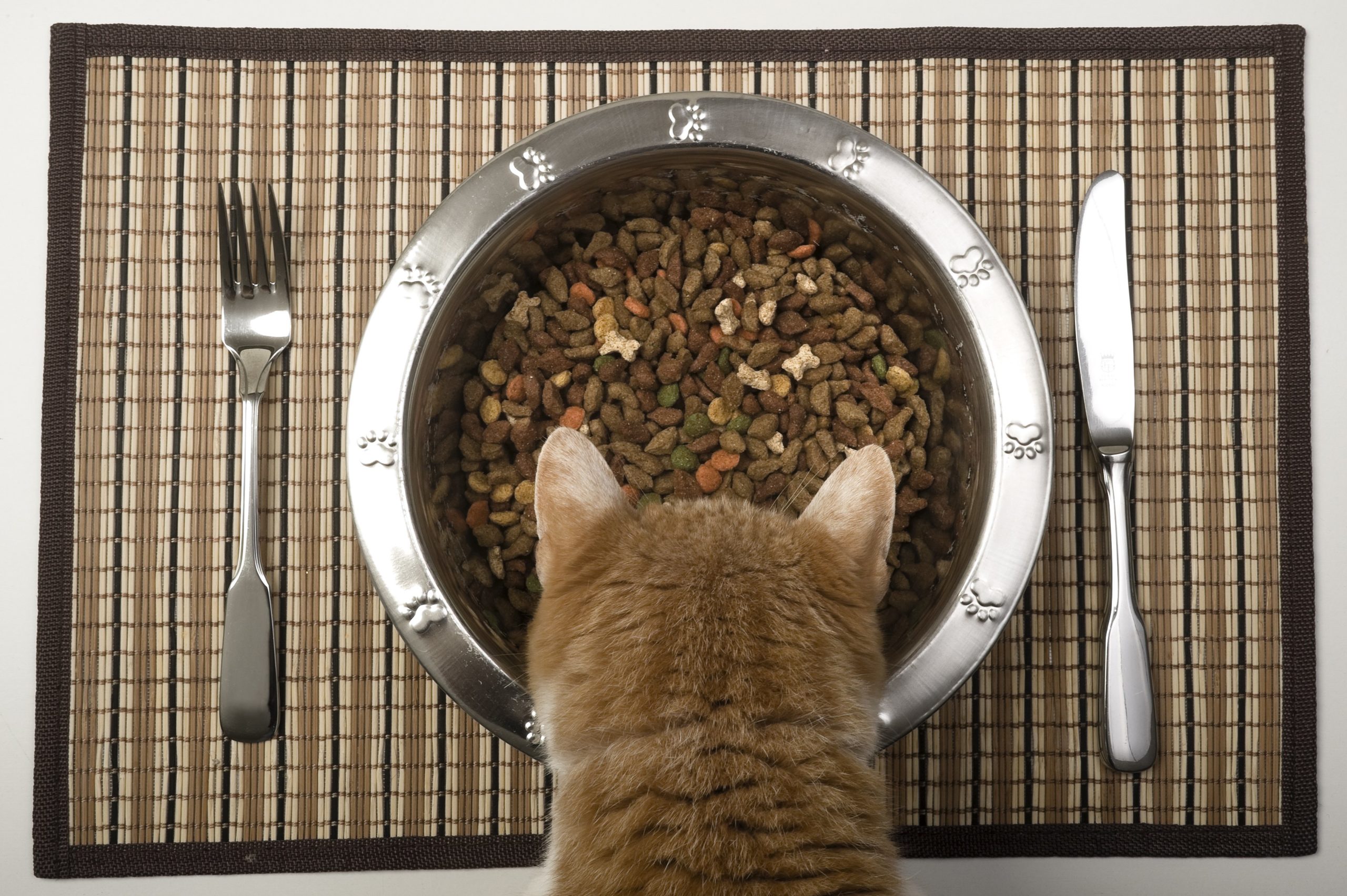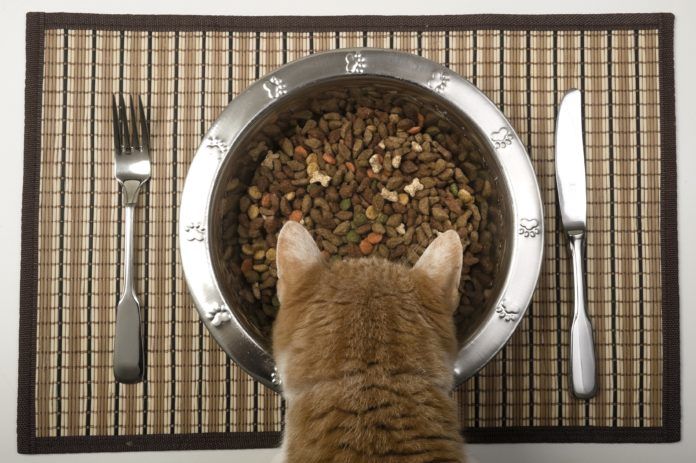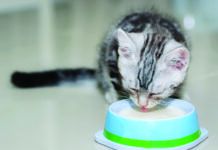When your cat is diagnosed with diabetes, it’s certainly going to require a lifestyle change for your pet, explains Deborah Linder, DVM, Head of Tufts Obesity Clinic for Animals at the Cummings School of Veterinary Medicine. “Your cat can do very well, and have an excellent quality of life for many years,” she says. “But it does require intensive management by the owner.”
In most cases, you’ll need to become accustomed to giving your cat insulin injections twice a day, usually timed in conjunction with feeding. “If the cat and the family are amenable, we switch to canned foods that the cat can eat twice a day, and he receives insulin at the same time,” says Dr. Linder, who is board-certified by the American College of Veterinary Nutrition.
So, if you’ve gotten into the convenient habit of pouring some kibble into a bowl or if you use an “ad libitum” auto-feeder, you’ll need to get into different habits. And if you’re accustomed to occasionally leaving your cat over the weekend — perhaps with an auto-feeder —you’ll need to find someone who can feed your cat and administer insulin, too. “Cats with diabetes usually need their meds twice a day,” says Dr. Linder.
The benefit, however, will be a cat that is healthier and more energetic. “By sticking to a good diet regimen, with consistent foods, and working with your vet, you can keep your cat out of the hospital. You can also reduce the likelihood of him not feeling well — which will keep him happy and provide a higher quality of life,” says Dr. Linder.
Even better, a good regimen for your cat — including weight loss — may help your diabetic cat go into remission. About six out of 10 cats with diabetes treated with insulin, proper diet and weight loss will go into remission — although about a third of them will eventually need insulin again. Owners should understand that remission is most likely when a cat is diagnosed and treated within six months of developing diabetes.
Thinkstock


“My goal for each cat who is already diagnosed is to get them off medication, and to get the cat into a state of remission,” says Dr. Linder. “It does not happen with every cat, but even in those cases, with safe weight loss, we can at least reduce insulin requirements.”
Starting Your Cat’s Diabetes Diet
Cats can get diabetes at any age, but it’s more common with age — the average age of diagnosis is seven years. And just like humans, obesity is a major risk factor. “Cats are so much more prone to diabetes if they are overweight,” stresses Dr. Linder. “In terms of prevention, the best way to avoid diabetes is to keep them at a healthy weight.”
If your cat develops diabetes, the signs are usually clear-cut. Your cat will drink more and urinate more. “It’s not just a little bit, but a lot — it’s very noticeable,” she says. “When someone comes in to my office and says, ‘My overweight cat is drinking and urinating more than usual,’ one of my first thoughts is diabetes.”
Once symptoms arise, your vet will do physical exam and a series of tests — including blood glucose (sugar) levels — for a proper diagnosis. In some cases, it makes sense to test blood glucose levels even in the absence of symptoms, especially if your pet is an older, overweight cat. “It’s not required, but it’s good to do preventive or wellness checks as your cat nears middle age. If we pick diabetes up early enough, even before symptoms, some cats can reach remission and not need medication,” says Dr. Linder.
If your cat is diagnosed with diabetes, your veterinarian will likely administer long-acting insulin right away, and get your cat started on a new diet. The purpose of the diet is twofold: To give your cat a balanced diet that is moderately low in carbohydrates to control blood sugar, and to help your cat lose weight gradually and safely if overweight.
OTC vs. Prescription Diets for Feline Diabetes
The best diet for a cat with diabetes is generally high in protein, moderate in fat and low in carbohydrates. While there is no evidence that dry food causes diabetes (see “Myth Buster: Dry Food and Diabetes”), once a cat has diabetes, restricting carbohydrates is the first choice. Canned foods are often the preferred choice, since they tend to have fewer carbohydrates per serving than dry food. (Another dietary approach — high fiber/low fat — can also work with some cats, she adds.)
Some owners ask: Should I just cut carbs out entirely? After all, there is no known requirement for carbohydrates in cats. However, that’s actually not the best approach. “My concern lies with the calories,” says Dr. Linder. “If we take out all the carbohydrates in a cat’s diet, we are left with just protein and fat, and that tends to be a high-calorie diet.” Because weight loss is so important, that means you’ll have to feed your cat just a small portion if your food is calorie dense. According to Dr. Linder, “Many cats do not find that acceptable.”
Choosing a regular over-the-counter (OTC) canned food — or a prescription diet — is up to you, your veterinarian and also your budget. “There are plenty of OTC diets that I am comfortable recommending,” says Dr. Linder. “As long as the carb/protein/fat levels meet our nutritional goals and the food is complete and balanced, your diabetic cat will likely do fine. The minimum essential nutritional requirements are the same for cats with diabetes and those without. The only drawback is that there may be somewhat less consistency between batches in commercial OTC foods compared with prescription ones. With diabetes, we try to keep everything as consistent as possible.”
If you go with an OTC diet, work with your veterinarian to choose the right one. Since nutrition labels don’t provide a full nutrient profile, for example, your vet may want to contact the company to make sure it’s the right diet for you cat. “You can bring in a few diets to your vet and ask which one is best,” she suggests.
Another approach is a therapeutic diet, which tends to be more costly. Your vet can write a prescription, which you can fill either at the office, in a pet store or online. “Some of these therapeutic diets have been through research studies and trials, so there is information on how they work in diabetic cats. That can be helpful.”
Help Your Cat Make the Change to Diabetic Foods
Most cats don’t like abrupt dietary change. So take your time — over the course of at least a week — when making the shift in diet. “Some cats like foods mixed together,” she says. Other cats, especially those who appreciate new things, will do well if you give them the customary food, and the new food in a separate dish. Over time, switch to the new food.
Be careful with treats now, too. “Ideally, you would only give them food when you give them insulin,” says Dr. Linder. “But if you have one special treat, we can work it into the program so that you give it every day and keep it consistent.”
Be patient with weight loss, too. “We want weight loss to happen very slowly, very gradually,” she says. Your vet should check your cat regularly to make sure that she is losing fat but not too much muscle in her weight-loss routine. As your cat loses weight, she says, “We’ll need to check the medications, and usually make an adjustment.” Her usual recommendation is to aim for a weight loss of one-half a percent of your cat’s weight per week until the ideal weight is achieved. “Once your cat has lost weight, she won’t require as much insulin.” That’s why it’s important to stay in touch with your veterinarian as you learn how to feed your cat with diabetes. — Bob Barnett



